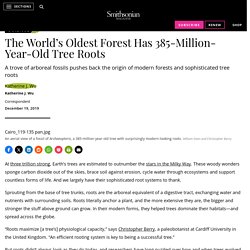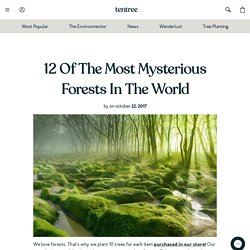

The World’s Oldest Forest Has 385-Million-Year-Old Tree Roots. At three trillion strong, Earth’s trees are estimated to outnumber the stars in the Milky Way.

These woody wonders sponge carbon dioxide out of the skies, brace soil against erosion, cycle water through ecosystems and support countless forms of life. And we largely have their sophisticated root systems to thank. Sprouting from the base of tree trunks, roots are the arboreal equivalent of a digestive tract, exchanging water and nutrients with surrounding soils. Roots literally anchor a plant, and the more extensive they are, the bigger and stronger the stuff above ground can grow. In their modern forms, they helped trees dominate their habitats—and spread across the globe.
“Roots maximize [a tree’s] physiological capacity,” says Christopher Berry, a paleobotanist at Cardiff University in the United Kingdom. But roots didn’t always look as they do today, and researchers have long puzzled over how and when trees evolved their expansive underground plumbing. Scientists On How Trees Talk Through Ancient 'Otherworld' Network. As a participant in the Amazon Services LLC Associates Program, this site may earn from qualifying purchases.

We may also earn commissions on purchases from other retail websites. Trees talk to each other deep underground. It’s an idea still relatively new to science but familiar to ancient beliefs. Today, scientists are confirming that forests act like one big superorganism. Below the ground, fungal highways connect the trees. Trees Talk on the ‘The Wood-Wide Web’ Why do leaves change color? Fall foliage, explained - City of Spokane, Washington. Josh Morrisey, City of Spokane Parks & Recreation, Marketing Assistant, 509.625.6236 Tuesday, October 1, 2019 at 5:03 p.m.

Right about now, you’re probably noticing the previously green leaves of Spokane’s park trees slowly turn an array of yellows, oranges, and reds. It’s not a surprise. After all, this happens every year. But why? The fireworks show of fall color creeping its way across Spokane is magical to watch, but has a scientific explanation. Chlorophyll: The chemical responsible for the green we see in leaves. Carotenoids and Flavonoids: Pigments present in leaves year-round that contribute to the yellow and orange colors you see in fall.
Anthocyanins: Pigments present in leaves towards the start of fall that contribute to red and purple hues. 25 Photos of Madeira's Dreamy Fanal Forest by Albert Dros. The island of Madeira is known for its dramatic landscape, which includes rugged mountains, volcanoes, and rocky beaches.

But one of Madeira’s most unique treasures is an ancient forest where every step takes you inside a scene ripped from a fairy tale. Known for its enchanting morning fog, the Fanal forest is part of an ancient laurel forest. Thanks to incredible images by photographer Albert Dros, we’re transported into this dreamy landscape. Fanal is part of the Laurisilva forest, a UNESCO World Heritage Site known for its beauty and ecological importance. Incredibly, 15 to 40 million years ago, much of Southern Europe was covered in this type of laurel forest.
Dros shows every aspect of the picturesque forest from dusk to dawn. Clara Ben - Bamboo forest Kyoto. 25 Photos of Madeira's Dreamy Fanal Forest by Albert Dros. Japanese Experiment That Took Half A Century Ended In Amazing Tree ‘Crop Circles’ Crop circles are a staple of the conspiracy theory crowd, with the artistic creations in cereal fields often attributed to UFO landings, or intricate forms of Alien communication. So imagine the excitement some must’ve felt when photos of incredible geometric designs emerged in a forest in Japan recently, not from some squashed wheat, but from large, mature Japanese cedar trees. What kind of extra-terrestrial sorcery is this? Sadly, for those who want to believe, there is a perfectly innocent, yet still interesting explanation that originates firmly here on planet Earth. Back in 1973 scientists began a project in ‘experimental forestry,’ with the aim of learning about the spacing of trees and its effect on growth.
They planted circles of cedars near Nichinan City in Miyazaki Prefecture, with smaller inner circles expanding incrementally into larger radiuses to create 10 perfect rings. As you can see in the photo below, the experiment seems to show clear results. Makes sense right? 12 Of The Most Mysterious Forests In The World – tentree. We love forests.

That's why we plant 10 trees for each item purchased in our store! Our tree planters work hard creating new new mysterious forests. Being a tree planter is a fulfilling, though at times a very very difficult job. The days are long, the work is hard, but few things are more rewarding. While tentree doesn't currently have any job openings for tree planting, here's how to get yourself a job in the field. (4) Facebook. Photographer Captures the Enchanted Forests of Wistman’s Wood. Deep within the forests of Dartmoor, England is Wistman’s Wood, an ancient woodland that looks like something from a fairytale.

Featuring moss-covered boulders and tangled web of twisted trees, it’s no surprise that the eerie location is associated with a number of supernatural folklore tales—many writers have even described the woodland as “the most haunted place on Dartmoor.” However, this fearful reputation didn’t scare away fine art photographer Neil Burnell, who braved the foggy forest to capture its enchanting charm. Aptly titled Mystical, Burnell’s ongoing series transports the viewer to an extraordinary world that’s largely been left to grow wild. His images show how the ancient trees have spread their branches and twisted their roots around giant granite boulders, while a thick carpet of moss covers the entire forest floor.
“I love to try and produce an atmosphere in my images and Wistman’s is one of the most atmospheric places I’ve visited,” Burnell told My Modern Met. For Love of The Forest - Yellow Point Ecological Society.